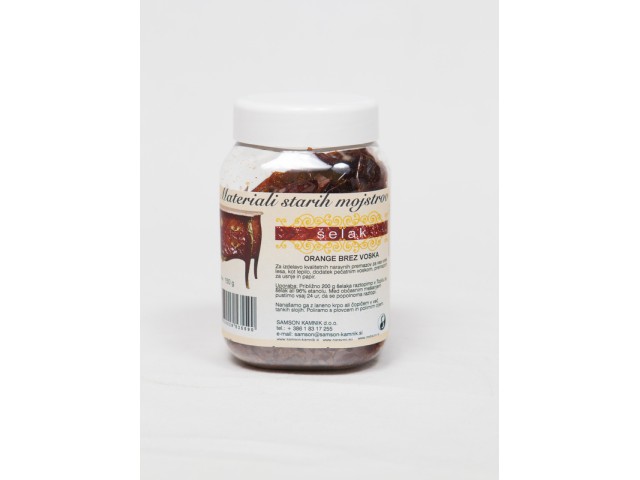Naziv vsebine
SHELLAC ORANGE without wax 150 g or 500 g
| 150 g |  Date of delivery not known Date of delivery not known | 11,59 € | ADD TO CART | ||
| 500 g |  Date of delivery not known Date of delivery not known | 32,94 € | ADD TO CART |
SHELLAC
HISTORY and EXTRACTION
With the development of new overseas trade routes to the Far East, shellac appeared in Europe in the 17th century.
It is a resin of animal origin secreted by scale insects (Kerria Lacca, Collus Lacca, Tachardria Lacca Kerr, and several other Tachardria insects) that feed on the resin of various tree species such as Croton lacciferum, Euphorbiaceae, Ficus religiosa, Artocarpus, and some species of Butea, primarily in Eastern India, Sri Lanka, and the Antilles.
Raw shellac is collected on tree branches as a 3-8 mm thick crust, which contains numerous female scale insects. The locals collect it, crush it, and wash it with water. This removes wood fibers, sugars, water-soluble salts, and the red dye lac dye. Shellac is then heated, filtered through fabric, and the resulting melted mass is manually stretched into thin layers, similar to dough. Once cooled, it is manually or mechanically crushed into flakes of various sizes or ground into powder.
VARIETIES OF SHELLAC
Filtered and ground shellac contains up to 5% wax. Depending on the type of wood and its geographical location, shellac varies in color. The most characteristic representatives are:
-lemon (yellowish color)
-orange (orange-brown color)
-ruby (reddish-brown color)
For polishes with a particularly high gloss, the following are used:
-decolorized shellac without wax (almost colorless or slightly yellowish in thin layers)
-shellac gold
-shellac orange without wax
PREPARATION OF SHELLAC
To prepare the polish, shellac is dissolved in ethanol or a combination of alcohols (e.g., Shellac solvent – Samson Kamnik d.o.o.). For the highest quality polishes, various other natural resins are also added to the shellac solution, such as mastic (resin from Pistacia lentiscus from Chios-Greece), copal (fossil resin from Zaire or resin from living trees Trachylobium, Hymenaea courbaril from Zanzibar, Mozambique, Australia).
The usual concentration of shellac in the solvent is 12-20%. The solution is left to stand overnight, then filtered. The prepared polish can only be stored for a few months because the drying times of the polish are extended due to hydrolysis.
POLISHING
Making quality polish requires quite a bit of skill and experience.
The process can be summarized in the following phases:
A/ Priming - rubbing in diluted polish
B/ Filling pores
C/ Covering polish
D/ Smoothing: - polishing
- re-polishing
Before polishing, the surface is sanded with sandpaper 600 or 800 or steel wool 000. The most important tool for polishing is the pad. It is made from cotton or wool, wrapped in a linen cloth. For priming and filling pores, coarse linen cloth is used, while finer cloth is used for covering polish and smoothing. The pads are stored in a well-sealed glass container.
Priming:
The pad is soaked in a strongly diluted polish, which is poured into a shallow container, and rubbed into the surface of the wood with longitudinal and transverse movements. It is left to dry thoroughly overnight.
Filling pores:
The same pad used for priming can be used. Now, undiluted polish is applied under the pad, and ground pumice is added. Pumice is a volcanic rock with a microporous structure and is used as a mild abrasive.
Wood dust created during sanding, pumice powder, and dissolved shellac form a filling mixture that must be rubbed into the wood pores with the pad.
Care must be taken not to add too much pumice, as this will turn the pores gray.
Dry for at least 1 hour.
The surface is then sanded with fine sandpaper.
Covering polish:
A firm pad is formed, soaked in undiluted polish, and applied with longitudinal and transverse strokes, first with stronger pressure and then with lighter pressure. The pad is replaced 1 to 2 times. Care must be taken not to drag the pad over the still wet surface or tear the already formed polish film. A few drops of polishing oil can be used to moisten the polishing pad from underneath. If the underside of the pad begins to shine, it is a sign that the cloth is clogged. This cloth must be washed with alcohol. The last pad must be polished until it is completely dry. This will bring the residues of polishing oil to the surface. Dry for at least 2-3 hours.
Lightly sand again with fine sandpaper 600-800 or pumice powder.
Smoothing - polishing:
The pad is used with a fine linen cloth in combination with shellac polish with a few drops of polishing oil. Quick, circular movements are made with the polishing pad.
Let it dry overnight. Then sand only the poorly or less well-treated areas with pumice powder.
Let it dry for 2-3 days if possible.
Smoothing - re-polishing:
A fresh pad is prepared with the finest linen cloth. Strongly diluted polish and a few drops of polishing oil are used, and polished with gentle, circular movements. Finally, only alcohol is added to "extract" the last residues of polishing oil. The linen cloth is changed several times so that the residues of oil do not cloud the surface again.
The polish is dry after at least 60 hours.
Although shellac polish is properly applied, the surface is relatively sensitive to water, heat, and solvents.
Nevertheless, shellac polish has a special aesthetic effect and still represents a high level of craftsmanship in the treatment of wooden surfaces.







